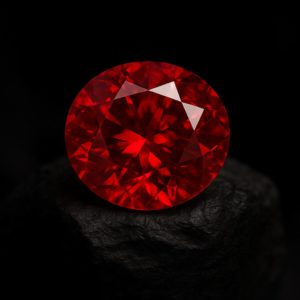RUBY

Ruby, also known as red corundum, is a precious variety of the mineral corundum whose intense red colour is due to traces of chromium. This mineral is one of the hardest in the world, ranking second on the Mohs scale with a hardness of 9 out of 10, just after diamond. Thanks to its exceptional durability and beauty, ruby has been prized throughout history, not only for its aesthetic value in jewellery but also for its unique properties in technical fields such as watchmaking.
Physical properties of ruby
Ruby has great transparency and brilliance, making it a sought-after gemstone in the luxury industry. Its red colour can vary according to the intensity of chromium present, ranging from lighter tones to darker reds, even approaching violet. In addition to its hardness, ruby is extremely stable both thermally and chemically, making it suitable for use in demanding conditions.
Use in watchmaking
- In the movement: The use of rubies in watchmaking dates back to the early 18th century. In 1704, Nicolas Fatio de Duillier and Pierre Debaufre succeeded in drilling and polishing rubies to create pivot bearings for wheels. The steel–ruby combination minimises friction to the scale and requirements of watch movement components, significantly improving movement efficiency and reducing wear.
Initially used specifically for the bearings of balance wheels, escapements, and seconds wheels, rubies gradually came to be used throughout the movement (depending on the quality of the calibre), including in escapements (detent or lever pallet stones, impulse jewels or cylinders, impulse pins, etc.), and even as rollers or bearings.
In 1902, Verneuil lent his name to the process for synthesising corundum. Synthetic rubies gradually replaced natural stones in watch movements, becoming universal by the mid-20th century. Synthetic corundum shares all the properties of natural ruby but contains no inclusions, making it far less prone to breakage. Furthermore, by adding different oxides, synthetic rubies can be given a chosen and uniform colour for all the jewels in a movement.
- In the exterior: Rubies are among the most prized gemstones in jewellery. They are used to decorate dials, watch cases, and bracelets, and can be cut in most known styles (faceted or cabochon).
Conclusion
In summary, whether natural or synthetic, ruby is far more than a mere precious stone in watchmaking. Thanks to its hardness, wear resistance, and stability, it is a key element in watch mechanics, ensuring both the precision and durability of movements as well as the aesthetic appeal of timepieces.
